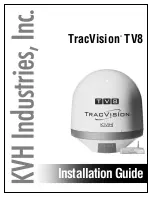
2
Coaxial Cable Installation Precautions
• Do not bend coaxial cable (RG-6/U) into less than a
3-inch radius. Tighter bends can cause shorts and
change the cable’s impedance.
• Do not install coaxial cable where it will have a pulling
tension of greater than 50 pounds. Leave no tension
on the cable after installing it.
• Use only round-headed staples. Any clamps or
securing devices used with coaxial cable should grip
the cable evenly about the circumference without
crushing the cable. Flat staples can damage coaxial
cable.
• Do not expose coaxial cable to a temperature greater
than 176°F (80°C). Keep the cable away from heat-
ing vents and water heaters.
• Do not install coaxial cable where it will be crushed,
stuffed, wedged, or pinched.
• The cable jacket withstands most outdoor environ-
ments. However, you must seal connections and
splices against water entry.
MOUNTING THE ANTENNA
You can mount your antenna indoors or outdoors on just
about any flat surface. For the best results, mount the an-
tenna horizontally as high as possible away from trees or
other obstructions. (Higher frequencies are noticeably af-
fected by obstructions.) Make sure the front of the anten-
na faces the general direction of the nearest TV station’s
broadcasting antenna.
Important: Do not mount the antenna on any metal sur-
face such as aluminum siding. This greatly reduces the
antenna’s ability to receive signals.
Outdoor Mounting
1. Mark the position for the center mounting screw hole
on the mounting surface.
2. In the marked location, drill a hole slightly smaller
than one of the supplied 1
1
/
4
-inch screws.
Caution: Be careful not to drill into any objects
behind the surface.
3. Thread one of the supplied screws through the an-
tenna’s center mounting hole. Then use a Phillips
screwdriver to temporarily secure the antenna to the
mounting surface.
Hint: To make sure the mounting location you chose
is the best place for reception of all channels, follow
the steps in “Connecting the Antenna” on Page 3
then tune each of your TV’s channels. If you can tune
all channels, continue with Step 4 to finish mounting
the antenna. If you cannot tune one or more of the
channels, move the antenna to another location and
try again.
4. If necessary, use a carpenter’s level or other leveling
device (not supplied) to make sure the antenna is
horizontal. Then mark the positions for the left and
right screw holes on the mounting surface.
5. In each marked location, drill a hole slightly smaller
than the screw.
6. Thread the remaining supplied screws through the
antenna’s left and right mounting holes, then use a
Phillips screwdriver to tighten all screws and attach
the antenna to the mounting surface.
Indoor Mounting
You can also mount the antenna in an attic, closet, or other
out-of-the way indoor location. The antenna can be mount-
ed on a horizontal mast, closet rod, or on a short piece of
mast suspended from a roof support by a 4-inch wall-
mount bracket (such as Cat. No. 15-883, not supplied). Or,
you can simply place the antenna on a shelf in a closet. Be
sure the antenna is not in a position where it could easily
fall or be damaged.
(illus)






















